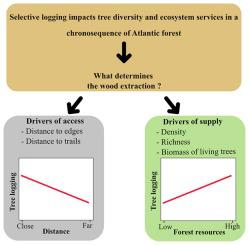Perspectives in Ecology and Conservation ( IF 4.0 ) Pub Date : 2021-06-29 , DOI: 10.1016/j.pecon.2021.06.003 José Alberes Santos da Cunha , Nathan Castro Fonsêca , Jéssica Stéfane Alves Cunha , Lúcia dos Santos Rodrigues , Reginaldo Augusto Farias de Gusmão , Ana Carolina Borges Lins-e-Silva

|
Selective logging impacts biodiversity and ecosystem services in forest ecosystems, but we know little about its main drivers in the Atlantic Forest. We investigated selective logging along a chronosequence (mature, late secondary and early secondary forests) in a State Park in Pernambuco, Brazil, and hypothesised that it is driven by variables of supply (forest age, density, richness and biomass of living trees) and access (nearest edge and declivity). Selective logging was described by richness, density and biomass of logged trees. We predicted the relationship of logging to be positive with supply and negative with the distance of access. Logged trees comprised 267 stumps, 55 species and 5.11 Mg.ha-1 in one year, corresponding to 2.8%, 20.8% and 0.37% of living trees density, richness and biomass. Selective logging was the highest in richness in mature forest, influenced by access and forest age. Access influenced higher species removal in the early-secondary forest, despite its lower richness, while the lowest logging values were recorded in the late-secondary forest, regardless of its higher supply than early-secondary forest. Logging occurs in more accessible areas, where tree species exploitation will depend on the available supply. In this scenario, integrated actions for biodiversity and ecosystem services conservation should account for socioeconomic demands, vigilance and control.
中文翻译:

选择性采伐大西洋森林的时间序列:驱动因素和对生物多样性和生态系统服务的影响
选择性采伐会影响森林生态系统中的生物多样性和生态系统服务,但我们对其在大西洋森林中的主要驱动因素知之甚少。我们在巴西伯南布哥州的一个州立公园调查了沿时间顺序(成熟、晚期次生和早期次生林)的选择性采伐,并假设它是由供应变量(森林年龄、密度、丰富度和活树的生物量)和访问(最近的边缘和下坡)。选择性采伐通过采伐树木的丰富度、密度和生物量来描述。我们预测采伐与供应的关系为正,与访问距离的关系为负。采伐树木包括 267 个树桩、55 个物种和 5.11 Mg.ha -1在一年内,分别对应活树密度、丰富度和生物量的 2.8%、20.8% 和 0.37%。选择性采伐在成熟林中的丰富度最高,受进入和林龄的影响。尽管其丰富度较低,但进入影响了早期次生林中较高的物种移除,而晚次生林中记录的采伐值最低,尽管其供应量高于早期次生林。伐木发生在更容易到达的地区,那里的树种开发将取决于可用的供应。在这种情况下,生物多样性和生态系统服务保护的综合行动应考虑到社会经济需求、警惕和控制。











































 京公网安备 11010802027423号
京公网安备 11010802027423号